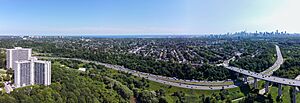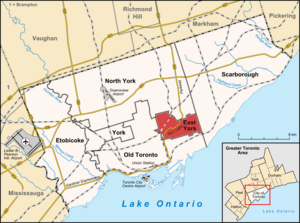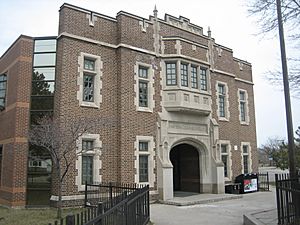East York facts for kids
Quick facts for kids
East York
|
|||
|---|---|---|---|
|
Dissolved borough (lower-tier)
|
|||

Don Valley Parkway in East York
|
|||
|
|||

Location of East York (red) compared to the rest of Toronto.
|
|||
| Country | Canada | ||
| Province | Ontario | ||
| Municipality | Toronto | ||
| Incorporated | January 1, 1924 (Township) January 1, 1967 (Borough) |
||
| Changed Region | 1953 Metropolitan Toronto from York County | ||
| Amalgamated | January 1, 1998 into Toronto | ||
| Area | |||
| • Total | 21.26 km2 (8.21 sq mi) | ||
| Population
(2021)
|
|||
| • Total | 116,399 | ||
| • Density | 5,475/km2 (14,180/sq mi) | ||
| Time zone | UTC-5 (EST) | ||
| • Summer (DST) | UTC-4 (EDT) | ||
| Postal code span |
M4B, M4C, M4E, M4G, M4H, M4J, M4K
|
||
| Area code(s) | 416, 647, and 437 | ||
East York is a district in Toronto, Ontario, Canada. It used to be its own town, called the Borough of East York, from 1967 to 1998. In 1998, it joined with other towns around Toronto to form the larger "megacity" of Toronto that we know today. Before this big change, East York was the last "borough" left in Ontario.
East York is separated from the old part of Toronto by the Don River. Most of East York is southeast of the river. However, some areas like Leaside, Bennington Heights, and busy Thorncliffe Park are northwest of the river. The main part of East York is known for its homes, where many middle-class and working-class families live.
Contents
History of East York
East York was once part of a bigger area called York Township, Ontario. In 1922, a new area called Township of North York was formed. This left the original York Township split up by Toronto, Leaside, and North Toronto.
Becoming Its Own Town
After the Bloor-Danforth Viaduct bridge opened in 1918, East York grew very quickly. People living in the eastern part of York Township felt that their area was being ignored. They needed better roads, sewers, and other services. They had to choose: either join the City of Toronto or become their own town. In the end, most people voted to create a new township. So, the Township of East York officially started on January 1, 1924. It had about 19,849 people at that time.
Early Residents and Growth
Many of the first people in East York were working-class English people. They came from places like Lancashire and Yorkshire and wanted to own their own small homes with yards. In 1961, over 70% of the people in East York said they had British family roots.
After World War II in the late 1940s, many soldiers returning home and their families moved to East York. The government built many affordable homes for them, especially around Topham Park. This helped house the growing number of families and babies born after the war. The local government worked hard to support its residents, and East York became known as a place with friendly neighbours and helpful community groups.
Becoming a Borough and Joining Toronto
In 1967, the Township of East York joined with the town of Leaside to form the Borough of East York. Leaside was a special community that had been planned for both factories and homes. For many years, East York was a popular place for older people to live. However, as original homeowners got older, younger families began moving to other suburbs for bigger houses. More recently, many neighbourhoods in East York have changed. Some older, smaller homes have been rebuilt with second floors, and some shops have become more modern.
East York used to have its own fire department with three stations. These stations are still used today by the larger Toronto Fire Services.
In 1998, the big change happened. Metropolitan Toronto and all its smaller towns, including East York, were combined. They became the new "megacity" of Toronto. The last mayor of East York was Michael Prue. He later became a city councillor for East York and then a Member of Parliament for the area.
During the COVID-19 pandemic, many people in East York worked together to fight against unfair rent increases. They held protests and organized to help each other.
East York's Location
East York is located near where the Don River flows. It shares borders with other parts of Toronto. To the east, it's next to Scarborough. To the west, it's near the older part of Toronto. To the north, it borders North York. East York is generally found north of Danforth Avenue, between the Don River and Victoria Park Avenue.
People of East York
East York is home to a diverse group of people. In 2001, about 115,185 people lived there. By 2006, the population was slightly lower at 112,054.
| Visible Minorities, 2006 | Population | Percent |
|---|---|---|
| South Asian | 19,315 | 17.4 |
| Chinese | 6,870 | 6.2 |
| Filipino | 4,625 | 4.2 |
| Black | 4,510 | 4.1 |
| West Asian/Arab | 2,510 | 2.3 |
| Latin American | 835 | 0.8 |
| Southeast Asian | 715 | 0.6 |
| Korean | 630 | 0.6 |
| Japanese | 610 | 0.5 |
| Other visible minorities | 1,735 | 1.5 |
Since the 1970s, East York has become a major place for immigrants to settle. Many new Canadians have moved into apartments in areas like Thorncliffe Park and Crescent Town. In 2001, almost half of the people living in East York (45.1%) were born outside of Canada. Many of these new residents arrived between 1991 and 2001. These groups include people from Bangladesh, India, Pakistan, Jamaica, the Philippines, and Sri Lanka. East York also has a strong Greek community and a growing Chinese community. In 2006, about 38.4% of the population were visible minorities, and 44.4% were immigrants.

When it comes to religion, most people in East York are Christian (about 63.4%). This includes Catholics and Protestants. There are also many Muslims (12.6%), Hindus (3.7%), Buddhists (1.6%), and Jewish people (0.9%). About 17.1% of the population does not have a religious affiliation.
East York is also home to the Estonian House. This building acts as an unofficial Estonian Consulate in Toronto. It hosts events, parties, and even an Estonian school.
While English is the main language spoken, nearly half (42.6%) of the people in East York said their first language was not English or French.
Schools and Learning
East York has many schools for students of all ages. Four different public school boards serve the area:
- Conseil scolaire catholique MonAvenir (CSCM)
- Conseil scolaire Viamonde (CSV)
- Toronto Catholic District School Board (TCDSB)
- Toronto District School Board (TDSB)
CSV and TDSB run public schools that do not teach a specific religion. CSV schools teach in French, while TDSB schools teach in English. CSCM and TCDSB run public schools that are connected to the Catholic faith. CSCM schools teach in French, and TCDSB schools teach in English.
Before 1998, the East York Board of Education managed the English public schools in East York. The Metropolitan Separate School Board managed all Catholic schools (both English and French). When East York joined Toronto in 1998, these boards were reorganized into the current ones.
Besides elementary and high schools, East York also has a campus of Centennial College. This college offers programs for students who have finished high school.
Sports and Activities
East York is a great place for sports! It has many different teams and clubs:
- Hockey: The Bulldogs, Victoria Village, and the Flames are hockey teams that play in local arenas like East York Arena and Victoria Village Arena. They offer hockey for boys and girls of all ages. The East York Lyndhursts even represented Canada in a world ice hockey championship in 1954!
- Soccer: East York Soccer, Clairlea Soccer, and the Leaside-East Toronto Soccer Club offer soccer for all ages. East York City FC is another local soccer team.
- Baseball and Softball: East York and Topham Park are home to baseball and softball organizations. They have teams for all skill levels.
- Other Sports: East York also has a well-known figure skating club, a gymnastics club, a lawn bowling club, and a curling club.
- Skateboarding: A local group called Team EY worked with the community to build the East York Skatepark in 2007.
The Leaside Memorial Community Gardens is the biggest recreation center in Leaside. It has an indoor swimming pool, an ice rink, a curling rink, and a large hall for events.





